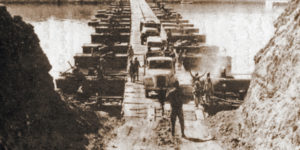Israel’s War of Attrition is Potently Relevant Today

Egyptian military trucks cross a bridge laid over the Suez Canal on October 7, 1973, during the Yom Kippur War. Credit: Wikimedia Commons.
Last week marked the 50th anniversary of the end of Israel’s least remembered conflict — the “forgotten war” — but one that still holds valuable lessons for today.
The War of Attrition with Egypt, referred to in Arabic as the War of Bloodshed, raged across the Suez Canal from 1968-70. As the names suggest, Egypt sought to bleed Israel, thereby reducing Jerusalem’s territorial conquests and military superiority from the 1967 Six-Day War.
On paper, Israel won the War of Attrition on the battlefield and in the ceasefire, which left the IDF in place along the canal. But actual victory proved elusive. The conflict ate away at some of Israel’s critical military advantages from the Six-Day War, particularly combat aircraft, and did little to prepare Israel for the 1973 Yom Kippur War that was around the corner.
Israel currently finds itself in another attritional conflict, this time with Iran and its proxies. To be sure, there are differences from 50 years ago. Back then, Israel was confident that its military successes would continue. Nevertheless, while Israel’s Bar Lev line of forts along the Suez Canal held up in the War of Attrition, it crumbled in 1973. Today, Israel’s choice to label its efforts against Iran the “campaign between the wars” suggests a more pessimistic outlook. The 1968-70 conflict with Egypt also imposed much greater casualties on Israel than anything Iran, Hezbollah, or others have inflicted since their last large-scale exchange with the Jewish state in 2006.
But the lessons of 1970 are acutely relevant today in at least one central respect. Just as the War of Attrition contributed to Israel’s unpreparedness for the sheer scale and ferocity of the onslaught in 1973, today’s conflict between the wars is wearing down critical IDF capabilities for its next major war.
Specifically, Israel is burning through tens of thousands of precision-guided munitions (PGM) that it has procured from the United States in recent years. Through thousands of airstrikes over several years, Israel has expended these PGMs to degrade Iran’s persistent proliferation of missiles, drones, and other military assets in Syria, Iraq, and Lebanon.
Israel is, therefore, running dangerously low on precisely the munitions it requires to prevail in a looming multi-front war that will be every bit as intense as 1973. It needs abundant PGMs to minimize collateral damage while still neutralizing Hezbollah’s more than 130,000 rockets and missiles in Lebanon, which the terrorist militia intentionally and illegally intersperses among civilian buildings. The war also could encompass Iran and its proxies around the region.
During the Yom Kippur War, the United States had to conduct an emergency airlift to resupply the IDF. Today America has the War Reserve Stockpile Ammunition-Israel, or WRSA-I. This forward-based US arms depot is intended to provide an insurance policy for Israel to access vital munitions in wartime, thus avoiding a costly and challenging repeat of 1973.
However, the United States faces various difficulties maintaining its own PGM stocks, let alone those for allies. Indeed, WRSA-I very likely contains mostly obsolete unguided “dumb” bombs. This deficit undermines a critical pillar of America’s commitment under US law to uphold Israel’s qualitative military edge over its adversaries, and threatens both countries’ deterrence against Iran.
Fortunately, there are several options to begin addressing this deficit, as laid out in a recent report from the Jewish Institute for National Security of America. With the US military’s demand for PGMs projected to decline in certain respects in coming years, the United States could start replenishing WRSA-I with critical PGMs. Most important will be Joint Direct Attack Munition (JDAM) kits to convert unguided bombs, as well as GBU-39 and GBU-53/B small diameter bombs.
At the same time, Israel could place larger, longer-term contracts with US defense firms. This may be the fastest path to addressing Israel’s PGM gap. Washington could help accelerate Israeli procurement by shifting forward, or “frontloading,” defense assistance funds agreed to in the 2016 Memorandum of Understanding. Frontloading would not require increasing the MoU’s annual cost to the United States.
The United States also could use the Special Defense Acquisition Fund to expedite PGM deliveries, by enabling the Pentagon to purchase weapons in advance of their sale to Israel. Finally, American policymakers should explore repurposing and expanding WRSA-I from a strictly bilateral stockpile into a regional prepositioning hub to support Israel’s projected wartime requirements, as well as those of the US military and potentially other regional allies.
Israel’s next major war is a question of when, not if. Though buried in the history books, the War of Attrition provides a cautionary tale about the need to ensure Israel has the tools to defend itself — and US interests — in the bigger conflict just over the horizon.
Jonathan Ruhe (@JCB_Ruhe) is Director of Foreign Policy at JINSA’s Gemunder Center for Defense and Strategy, where Ari Cicurel (@AriCicurel) is Senior Policy Analyst.
Originally published in Algemeiner